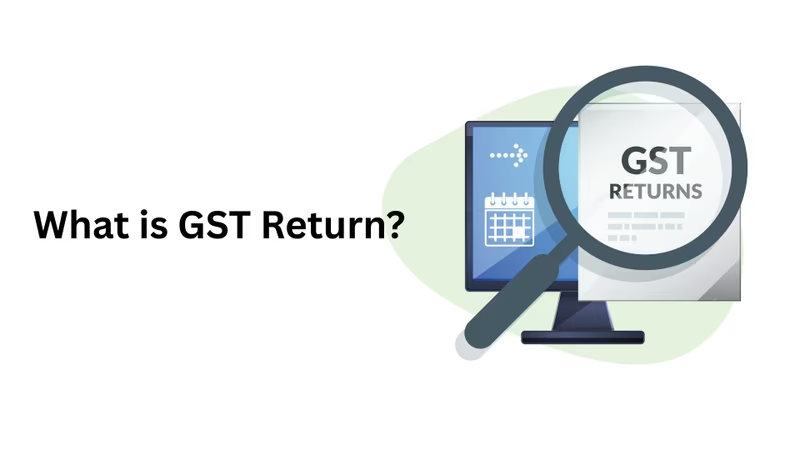In India, the Goods and Services Tax (GST) is a pivotal component of the nation's financial framework. Central to this system is the filing of GST returns, a mandatory compliance task for businesses.
For any entrepreneur or finance professional, a clear understanding of what is GST return is fundamental.
This blog will provide a detailed overview of GST returns for 2025. We will break down the essential definition of a GST return, explore its various types and simplify the filing process.
What is the GST Return?
A GST return is a formal document that every taxpayer registered under the GST Act must file with the tax authorities.
This document contains a summary of a business's transactions over a specific tax period. In simple terms, it is a statement that details:
- Outward Supplies: All sales of goods and services made by the business.
- Inward Supplies: All purchases of goods and services received by the business.
- Input Tax Credit (ITC): The GST already paid on purchases can be used to reduce the final tax liability.
- Total Tax Liability: The net amount of GST payable to the government.
Filing this return is the process of declaring your tax liability and remitting the tax owed. Understanding what is GST return means recognising it as the critical link between your business operations and the national tax system.
Types of GST Returns Explained
The GST framework uses different return forms for various taxpayers. Here is a simplified table of the most common returns in 2025:
|
Return Form |
Description & Purpose |
Who Should File It |
|
GSTR-1 |
Details of all outward supplies (sales) |
All regular registered taxpayers |
|
GSTR-3B |
A summary return to declare GST liabilities and pay taxes |
All regular registered taxpayers |
|
GSTR-4 |
Annual return for taxpayers under the Composition Scheme. |
Composition Scheme taxpayers |
|
GSTR-9 |
Annual consolidation of all monthly/quarterly returns |
Regularly registered taxpayers |
The 2025 GST Compliance Requirement: A New 3-Year Deadline
A monumental change is introduced to the GST system. Starting July 1, 2025, the GST Network (GSTN) will permanently block the filing of any GST return that is more than 3 years past its original due date.
This amendment, introduced via the Finance Act, of 2023, establishes a hard deadline for all taxpayers.
What this means: Previously, you could file a delayed return at any time, subject to penalties. From July 2025, that option will vanish for returns older than 3 years.
For instance, if your GSTR-3B for August 2022 was due on September 20, 2022, you must file it by September 20, 2025. After this date, the portal will permanently block filing for that period.
This will lead to an irreversible loss of Input Tax Credit (ITC) and can trigger severe legal complications. This new rule fundamentally changes the long-term perspective on what is GST return compliance, turning pending returns into time-sensitive liabilities.
GST Return Filing Process Step-by-Step
The filing process is systematic to ensure accuracy.
Step 1: Gather Data: Collect all sales invoices, purchase bills and transaction records for the period.
Step 2: Reconcile Information: Match your sales data with your accounting records and reconcile your purchase data with the auto-populated GSTR-2B on the GST portal to confirm your eligible ITC.
Step 3: Login and Navigate: Access the GST portal, go to the 'Returns Dashboard' and select the correct financial year and filing period.
Step 4: Prepare the Return: Choose the return (e.g., GSTR-1 or GSTR-3B) and opt to 'Prepare Online'.
Step 5: Enter Details: Fill in all required information. Much of the data in GSTR-3B is auto-filled from GSTR-1 and GSTR-2B. Always verify these figures.
Step 6: Submit and Pay: After verification, submit the return. If there is a tax liability, pay it through the portal.
Step 7: File the Return: Authenticate and file the return using a Digital Signature Certificate (DSC) or an Electronic Verification Code (EVC).
Upcoming Due Dates to File GST Returns for 2025
Meeting deadlines is critical. Below are the key upcoming due dates to file GST returns that businesses must follow in 2025.
|
Return Form |
Taxpayer Category |
Filing Frequency |
Due Date for 2025 |
|
GSTR-1 |
Turnover > ₹5 Crore or not in the QRMP Scheme |
Monthly |
11th of the next month |
|
GSTR-1 |
Taxpayers under the QRMP Scheme |
Quarterly |
13th of the month after the quarter |
|
GSTR-3B |
Turnover > ₹5 Crore |
Monthly |
20th of the next month |
|
GSTR-3B |
Taxpayers under the QRMP Scheme |
Quarterly |
22nd or 24th of the month after the quarter |
|
GSTR-9 |
Regular Registered Taxpayers |
Annual |
31st December 2025 (for FY 2024-25) |
Note: These are standard dates. Always monitor the official GST portal for any announced extensions. A clear understanding of these dates is integral to knowing what GST return compliance involves.
How to File GST Return Online (Portal Guide)
Filing returns online is a user-friendly process. Here’s how to do so:
Step 1: Login: Visit the GST portal and log in.
Step 2: Go to Dashboard: Click on ‘Returns Dashboard’.
Step 3: Select Period: Choose the ‘Financial Year’ and ‘Return Filing Period’.
Step 4: Prepare Return: Click ‘PREPARE ONLINE’ on the relevant return tile (e.g., GSTR-3B).
Step 5: Verify Data: Check the auto-populated values and fill in any remaining details.
Step 6: Save and Preview: Save the data and preview the draft return to check for errors.
Step 7: Pay and File: After paying any tax due, check the declaration box and file the return using DSC or EVC.
Learn all about the GST registration process.
Late Fees and Penalties for GST Return Delays
Failing to file on time attracts the following penalties:
- Late Fee: A per-day late fee is charged until the return is filed. For GSTR-1 and GSTR-3B, this is ₹50 per day (₹20 for nil returns), capped at a maximum amount depending on turnover.
- Interest: In addition to the late fee, interest at 18% per annum is levied on the unpaid tax amount. The interest is calculated from the day after the due date until the payment date.
Who Should File GST Returns in India?
The question of who should file GST returns has a simple and direct answer. That is, every person or entity registered under the Goods and Services Tax (GST) Act has to.
This obligation applies universally, regardless of the following factors:
- Business Activity: Whether you are a manufacturer, trader, service provider or e-commerce operator.
- Turnover: Even if your turnover for a specific tax period is zero, you are legally required to file a Nil return. There is no exemption from filing based on low or no business activity.
- Profitability: The requirement to file is independent of whether your business made a profit or a loss during the period.
Essentially, if you have a GST Identification Number (GSTIN), filing GST returns is a mandatory part of your compliance duties until you officially surrender or cancel your registration.
Save money in 24k digital gold on the Jar app.
Common Mistakes in GST Return Filing
Even with a clear understanding of what GST return filing is, errors can happen. Being aware of common mistakes can help you avoid them:
1. Incorrect Invoice Details in GSTR-1: Uploading invoices with wrong GSTINs, incorrect dates or wrong values can lead to mismatches and cause issues for your recipients when they claim ITC.
2. Mismatch Between GSTR-1 and GSTR-3B: The tax liability declared in your GSTR-3B must match the outward supplies reported in your GSTR-1 for the same period. Discrepancies are a major red flag for tax authorities. This often happens due to last-minute manual changes in GSTR-3B that are not reflected in GSTR-1.
3. Wrongly Claiming Ineligible ITC: Claiming Input Tax Credit on items listed under blocked credits (like food and beverages, motor vehicles for non-transport businesses, or construction of immovable property) is a frequent and costly error.
4. Not Reconciling GSTR-2B with Purchase Records: Failing to reconcile your purchase register with the auto-populated GSTR-2B can lead to either under-claiming or over-claiming of ITC, both of which can lead to notices.
5. Forgetting to File Nil Returns: Many businesses assume that no return is needed if there are no transactions. This is incorrect and leads to the accumulation of late fees, day by day.
6. Ignoring Reverse Charge Mechanism (RCM): Many businesses forget to pay GST on supplies subject to RCM, such as services from a Goods Transport Agency or legal fees from an advocate. The tax on these must be paid in cash, and then ITC can be claimed, a two-step process that is often missed.
Final Word
Knowing what GST return filing means understanding it as a core business function that offers transparency and financial discipline.
It is a periodic declaration of your tax position, vital for smooth operations. The approaching 3-year deadline in July 2025 brings a new urgency to compliance.
Businesses must act decisively to clear pending returns to avoid being permanently locked out of the system. Treat this process not as a chore, but as a crucial element of your strategy for long-term success.
Frequently Asked Questions
1. What is the meaning of the GST return?
A GST return is an official statement containing details of a taxpayer's sales, purchases, Input Tax Credit and tax liability, which must be filed with the tax authorities for a specific period. It is the primary mechanism for reporting and paying GST.
2. What are the main types of GST returns in India?
The main returns are GSTR-1 (for sales), GSTR-3B (a summary return for tax payment), GSTR-4 (for composition taxpayers) and GSTR-9 (the annual return).
The specific forms a business files depend on its registration type and annual turnover.
3. How can I file a GST return online?
You can file returns online through the official GST portal. The process involves logging in, selecting the return and period, verifying auto-populated data, paying any tax due and submitting the return using a DSC or EVC.
4. What is the penalty for late GST return filing?
The penalty includes a late fee (₹50 per day for regular returns, ₹20 for nil returns) and










